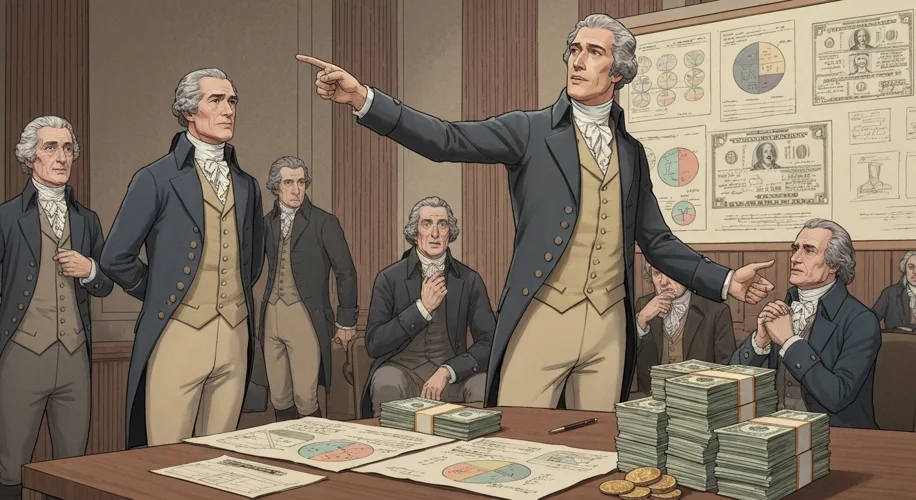The United States, a nation forged in revolution and economic aspiration, carries a burden that has grown with it: its national debt. It’s a complex tapestry woven from war, economic crises, policy decisions, and the very fabric of American ambition. This isn’t a new phenomenon; the echoes of past fiscal challenges resonate even today, as we grapple with the ever-mounting figures.
A Seed of Debt Planted in Revolution
Believe it or not, the very birth of the United States was financed, in part, by debt. The Continental Congress, desperate for funds to fight the Revolutionary War against Great Britain, borrowed heavily from foreign nations, primarily France, and issued its own currency, the Continental, which quickly lost its value. By the war’s end in 1783, the fledgling nation was already saddled with a significant debt. Alexander Hamilton, the first Secretary of the Treasury, recognized the debt not as a curse, but as a tool to establish the nation’s creditworthiness on the global stage. His vision was to consolidate state debts into a national debt, a move that was controversial at the time but ultimately laid the foundation for a stable financial system.
The Great Wars and Their Fiscal Echoes
Throughout American history, major conflicts have consistently been catalysts for debt accumulation. The Civil War, a fratricidal struggle that threatened to tear the nation apart, saw a dramatic increase in government spending and, consequently, debt. The Union government financed the war through bonds and by printing money, leading to inflation and a debt that dwarfed anything seen before. The early 20th century brought World War I. While the U.S. entered the war later than European powers, the mobilization of resources and the sheer cost of military operations led to another surge in borrowing. The subsequent Roaring Twenties, a period of economic prosperity, saw some debt reduction, but the seeds of future challenges were being sown.

Then came the Great Depression and World War II. President Franklin D. Roosevelt’s New Deal programs, designed to combat the devastating effects of the Depression, required massive government spending. The outbreak of World War II dwarfed even the Civil War in terms of fiscal impact. The mobilization of American industry and the global scale of the conflict led to an unprecedented increase in the national debt. By the war’s end in 1945, the U.S. national debt had reached nearly 120% of its Gross Domestic Product (GDP) – a staggering figure that would take decades to bring down.
Post-War Budgets and Shifting Tides
For a period after World War II, the United States experienced a remarkable era of fiscal responsibility. Through careful budgeting and economic growth, the national debt as a percentage of GDP steadily declined. However, this trend began to reverse in the late 1970s and accelerated through the 1980s. Factors such as increased defense spending during the Cold War, tax cuts, and growing social programs began to put upward pressure on the debt. The Savings and Loan crisis in the late 1980s and early 1990s also added to the burden as the government intervened to bail out failing institutions.
The Digital Age and Beyond: New Challenges, Old Debts
The late 1990s saw a brief period of budget surpluses, a rare glimmer of hope in the debt narrative. However, the new millennium brought its own set of fiscal challenges. The dot-com bubble burst, followed by the September 11th terrorist attacks and the subsequent wars in Afghanistan and Iraq. These events, coupled with significant tax cuts and increased spending on entitlement programs, pushed the national debt to new heights. The 2008 global financial crisis further exacerbated the situation, as government intervention was deemed necessary to prevent a complete collapse of the financial system.

As of 2025, the U.S. national debt stands at over $34 trillion, a figure that continues to grow. The factors contributing to this modern mountain of debt are multifaceted: ongoing defense expenditures, the rising costs of healthcare and social security for an aging population, interest payments on the debt itself, and ongoing investments in infrastructure and new technologies. Political divisions often make bipartisan solutions difficult to achieve, with debates raging over the balance between spending cuts and tax increases.
The Unseen Consequences
The implications of a continuously growing national debt are significant and far-reaching. High debt levels can lead to increased interest payments, diverting funds from essential public services like education, infrastructure, and research. It can also contribute to inflation and potentially devalue the U.S. dollar, impacting its status as the world’s reserve currency. Furthermore, a large debt can limit the government’s flexibility to respond to future economic crises or national emergencies.
Understanding the history of the U.S. national debt is not merely an academic exercise. It is crucial for comprehending the economic and political forces that have shaped the nation and for making informed decisions about its future. The mountain of debt may seem daunting, but by understanding its origins and the forces that drive its growth, we can begin to chart a more sustainable fiscal course for generations to come.


